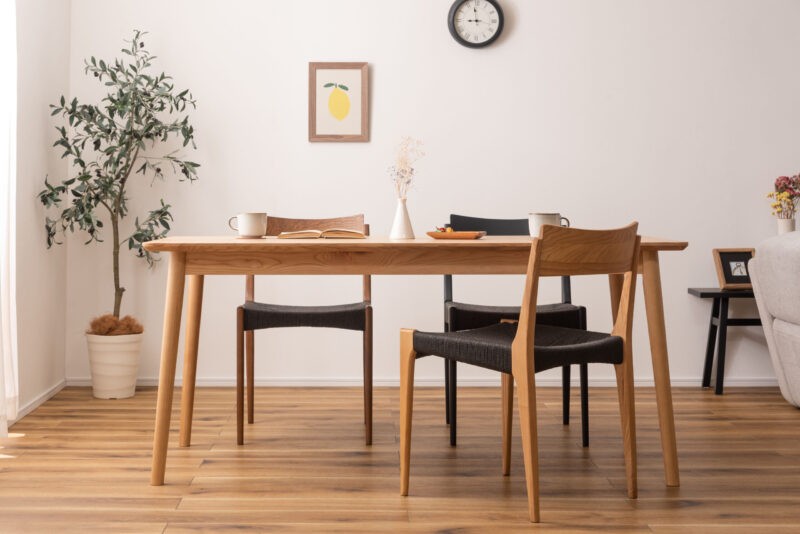Solid wood oil-finished tables are beloved for their beautiful appearance, rich patina that develops with use, and durability that ensures longevity in furniture. However, due to everyday use and environmental factors, the appearance and texture of the table may deteriorate over time.
In this article, we will delve into the maintenance of solid wood oil-finished tables, providing detailed steps and tips to preserve their beauty and ensure long-term enjoyment.
At daus lab, the items listed under the “Material” section on the product pages as “Natural Wood” with an “Oil Finish” are subject to specific maintenance requirements to uphold their quality and aesthetics over time.
Proper Protection Measures
To protect your table from stains and scratches, it is recommended to use coasters, runners, placemats, and other protective accessories.
When placing hot beverages or food items on the table, use mats or trivets to shield the surface from heat. Additionally, avoid placing sharp objects or rough surfaces directly on the table.
Using coasters is essential to prevent water stains and marks caused by placing glasses or cups with water droplets directly on the tabletop.
Proper Management of Humidity and Temperature Levels
Solid wood is sensitive to changes in humidity and temperature.
Excessive dryness or high humidity can cause the wood to shrink or expand. To maintain a consistent humidity level around the table, consider using humidifiers or dehumidifiers. It’s also important to keep the table away from direct sunlight and heating sources.
Regular Cleaning and Maintenance
To maintain the beauty of your solid wood table, regular cleaning and maintenance are essential.
Use a soft cloth or microfiber cloth to gently wipe the surface of the table. Regularly removing dirt and food crumbs helps prevent scratches and stains on the surface.
Dry dusting is usually sufficient. If there are stubborn stains, dampen a cloth with water and wring it out thoroughly before wiping. Afterward, it’s a good idea to dry the surface with a dry cloth to ensure no excess moisture remains.
Using Wood Oil or Wax
To preserve the protection and beauty of your solid wood table, it’s recommended to regularly use wood oil or wax.
For oil-finished tables, signs such as a dry surface or a faded color indicate the need for maintenance. Applying oil or wax allows the wood to absorb it, providing protection against moisture and dirt while enhancing the table’s luster and texture.
While there are specific wood oils and waxes for furniture, you can also use edible oils like linseed or sesame oil as alternatives. Since they are safe for consumption, there’s no harm even if accidentally ingested, and they do not contain harmful chemicals, thus avoiding the risk of causing sick house syndrome.
Flaxseed oil and perilla oil are classified as drying oils, which gradually solidify over time through oxidation when exposed to air. Conversely, edible oils such as salad oil and olive oil are considered non-drying oils and should not be used on furniture as they remain liquid and can cause a sticky residue.
Personally, I recommend using edible flaxseed oil for maintenance, as I, a furniture retailer, also use this method for maintenance.
Our solid wood oil-finished dining table at home has been in use for about seven years since purchase. When whitish areas, rough textures, or water stains from glasses become noticeable, it’s time for maintenance.
According to furniture manufacturers, maintenance with oil is recommended about every six months, but as a furniture retailer, I do it about once every two years.
The image below may not clearly show it, but there are some whitish areas and rough textures.
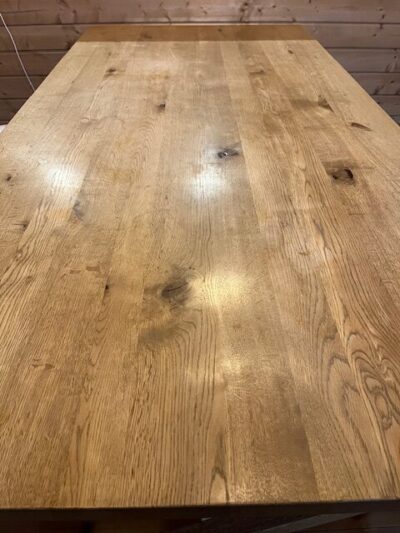
First, wipe the table thoroughly with a clean cloth. Applying a bit of pressure while wiping helps remove quite a bit of dust and dirt.
After this step, you’ll apply the flaxseed oil. However, if there’s still dust or dirt remaining, you’ll end up rubbing it in along with the flaxseed oil. So, make sure to wipe it down thoroughly.
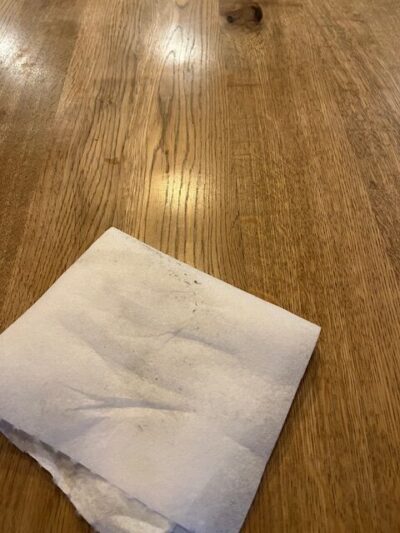
Once the wiping is complete, dampen a clean cloth with about a teaspoon of flaxseed oil, and then apply it along the grain of the wood.
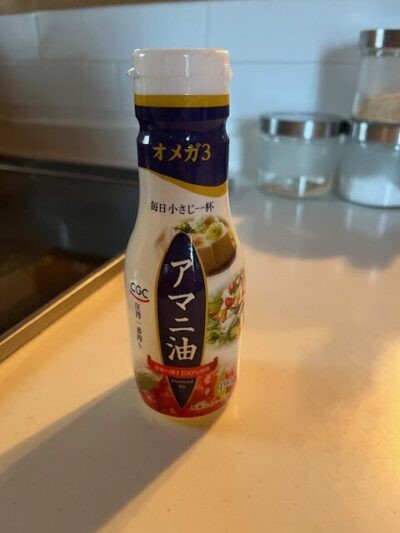
While applying flaxseed oil, it’s best to replenish it for each joined board to ensure even coverage.
If you’ve applied too much flaxseed oil, it will appear as excess on the surface. In such cases, use a cloth to trace over the excess and redistribute it to areas with less oil.
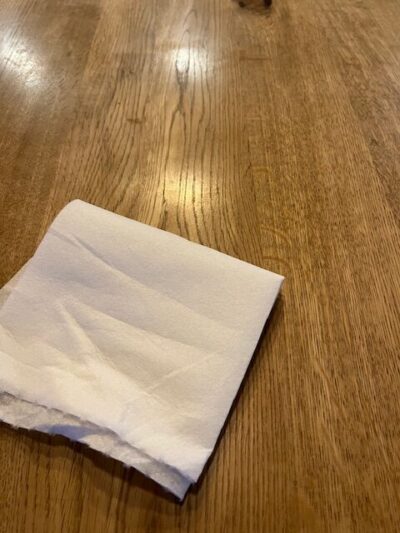
After finishing the application, let it dry for about 15 minutes, then wipe off any excess flaxseed oil with a cloth.
During this step, ensure to wipe until any streaks are no longer visible.
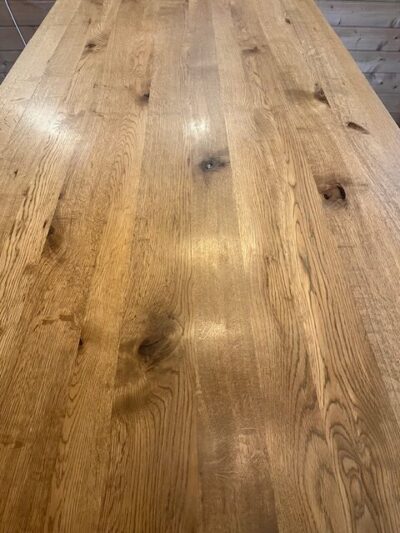
The table has regained its original color and wood grain, just like when it was purchased. The flaxseed oil has penetrated into the scratches that occurred during use, giving it a nice finish. All that’s left is to let it dry for a day or more.
Cloths soaked with flaxseed oil can pose a risk of spontaneous combustion, so be sure to soak them thoroughly in water before disposing of them.
Dealing with Scratches and Stains
If your table has scratches or stains, it’s important to deal with them properly.
For stains, gently rub them with a soft cloth or fine sandpaper and remove them as soon as possible. Be careful not to rub too hard as it may cause slight whitening of the surface. Applying oil or wax can help restore the original color.
Repair kits and wood repair products tailored to the type of wood and finish are available at hardware stores. You can use these to repair scratches, or if you’re skilled, you can prepare and process wood of a similar color and texture, fill holes or scratches with putty or wood dust. Repairing it yourself will enhance your attachment to the table even more.
For minor scratches, I would personally leave them as a part of our family’s history with the table.
If maintenance is challenging or if there are severe scratches or damage, don’t hesitate to seek advice from a professional
Summary
In summary, proper maintenance of your solid wood dining table is essential for preserving its beauty and longevity:
- Regularly wipe the table with a soft cloth or rag to remove dust and debris.
- Use coasters, placemats, or trivets to protect the table from heat, moisture, and scratches.
- Apply wood oil or wax periodically to nourish the wood and enhance its appearance.
- Wipe off any excess oil or wax and allow the table to dry thoroughly.
- Deal with scratches and stains promptly using appropriate techniques or repair kits.
- Consider seeking professional help for complex maintenance or severe damage.
By following these steps, you can maintain the pristine condition of your solid wood dining table and enjoy its beauty for years to come.


